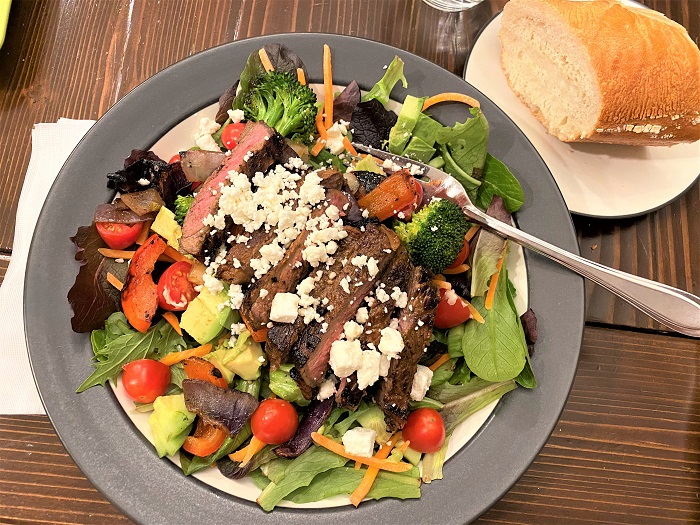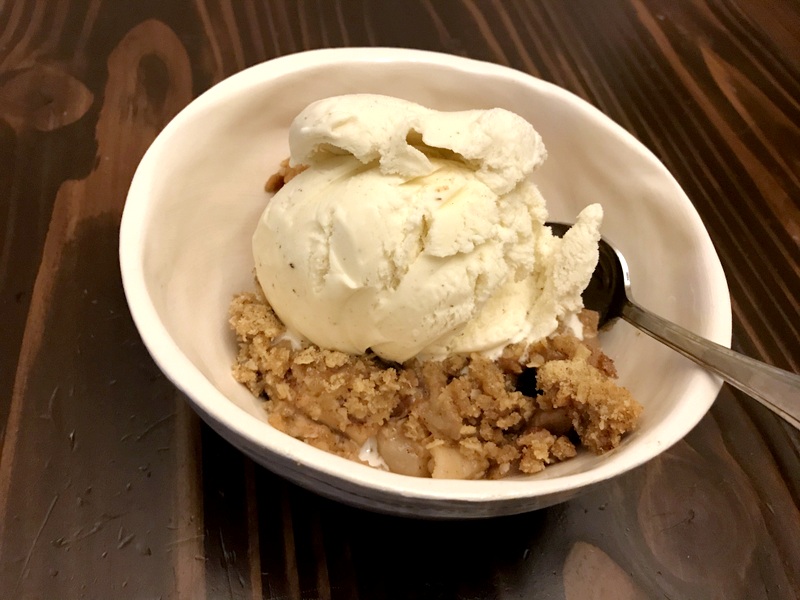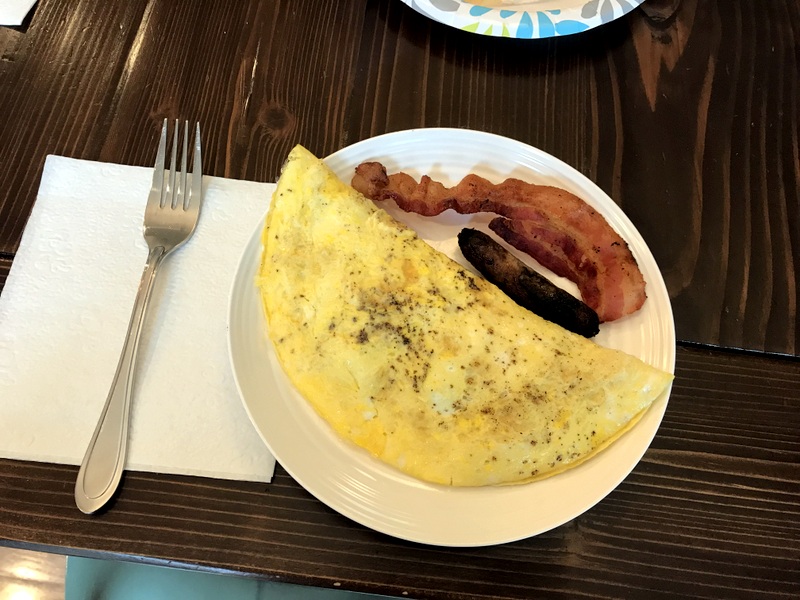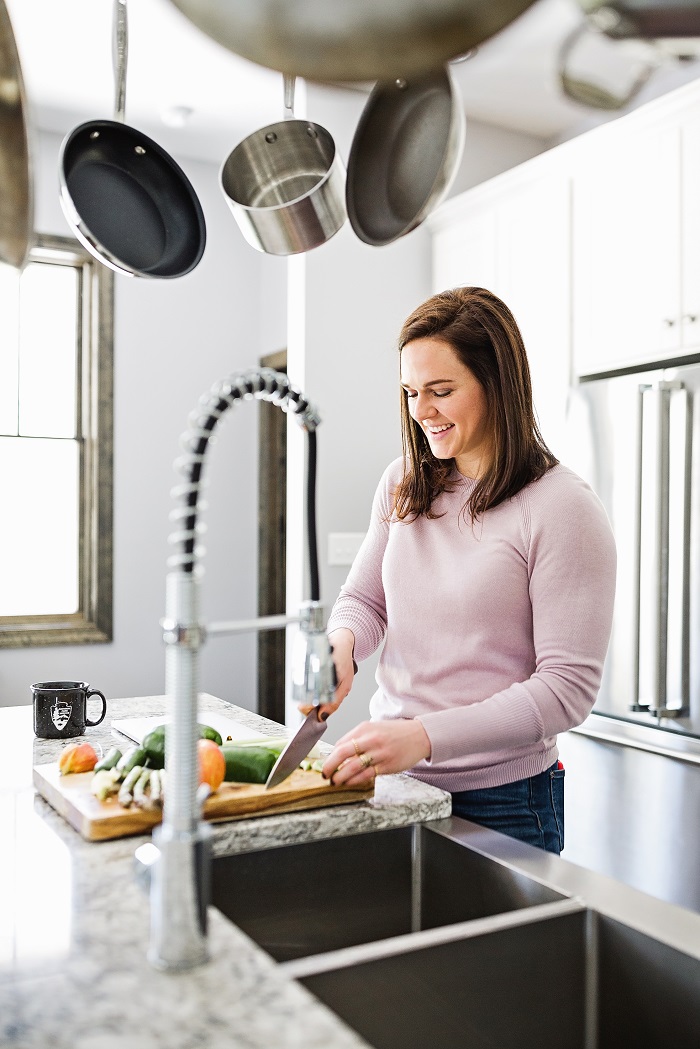When I wanted help reining in my sweet tooth and mindless snacking back in 2018, I turned to Emily Field, a Registered Dietitian and macros expert. By working with Emily one-on-one, I felt like I finally grasped what it means to eat a “balanced” diet—which, spoiler, doesn’t mean sacrificing my favorite treats!
I loved that Emily has a realistic approach to nutrition. While other macro coaches seemed hyper obsessed with cheat days, “eating whatever you want as long as it fit your macros,” hitting numbers no matter what, Emily offers a different, more sustainable and stress-free approach.
All that to say: This girl is the REAL DEAL who has helped hundreds of other macro-counting newbies through her online program, Macros Made Easy. Today, I’m so excited to share some of her wisdom with you on my own blog. Here are some of your burning questions you shared on Instagram about how to start tracking macros.
I’ll let Emily take it from here…!

What are macros and why would you track them?
The term “macros” is short for “macronutrients,” which refers to the large nutrients found in food. The three macronutrients that we are concerned about are protein, fat and carbohydrates.
Macros are what make calories “not equal.” For example, when you look at everything through a macros lens, 100 calories of broccoli is completely different than 100 calories of peanut butter. In contrast, if you are just counting calories, those two foods would be represented the same way. (Which doesn’t make much sense, right?)
For people who are used to tracking calories, changing to counting macros can feel like a big deviation. But it’s also the better method if you are interested in changing your body composition—rather than just scale weight. That’s why Courtney, who cared more about her health and fitness than weight, naturally clicked with the macro-tracking approach.

How do you set your macros? How do you get started with tracking?
Specific macro needs are determined with formulas. Generic macro calculators might simply take your sex, height, weight and weight goals into consideration when setting your macros, but a professionally set prescription will also take your food preferences, health history and athletic performance goals into account as well. The amount of protein, fat and carbohydrates that you eat each day can influence your hunger and satiety, overall energy, hormones, athletic performance, and body shape and size. That’s why the more information that is taken into consideration to “set your macros” is going to be better.
When you have your “best fit macro prescription” and are ready to start hitting your targets, I recommend using a food tracking app to start making small, incremental improvements. (More on that here!) It doesn’t have to be an overnight change!
For example, before tracking macros, Courtney might have opted for a fat-free yogurt + fruit for breakfast. Later, she might have had a big salad with black beans + cheese + olives + tortilla strips + salsa. Dinner was simple with the family, and she might have rounded out the evening with a bowl of ice cream.
After some experience with macro tracking, Courtney knows she needs to front-load her day with a bit more protein because her previous menu was lacking. She made some adjustments to her salad by adding chicken, turkey or ham and might choose to hold back on the cheese or tortilla chips. Macro tracking does not hold her back from enjoying sweet desserts, but now she knows how to better portion control or “make room” in her macros by cutting back somewhere else.

How do you meal plan around macros?
It’s easiest to meal plan around your macro targets by starting with a balanced macro plate. I call this “PFC eating,” which stands for protein, fat and carbohydrate. Eating all three macronutrients together not only makes for a satiating and filling meal, but keeps a person on track with hitting their macro targets by the end of the day. (In other words, you don’t have to scramble to create a frankenmeal at the end of the day!)
Let’s start with a standard breakfast example:
>> Carb-heavy and not PFC: granola + almond milk + fruit
>> PFC balanced: scrambled eggs + Canadian bacon + roasted red potatoes + butter
Whereas the carb-heavy breakfast will have you snacking within a few hours and already in the hole with your daily macros, the PFC meal will keep you full and on track to hit your daily macro targets. (More tips for meal planning here!)

Which apps are best?
There are several great apps out there with large food databases, barcode scanning features and user-friendly interfaces. The best app for you is the one that you enjoy using and that seems intuitive for you to use. I highly recommend Cronometer (free version is just fine!), but Fat Secret or My Fitness Pal also work well for tracking macros.
Do you need to hire a coach to get macro goals?
Nope! Some people do very well without ever hiring a coach to help them track macros. You can find your macro targets, start tracking your food, make adjustments to your typical eats and start seeing changes to your health, body composition and athletic performance without ever consulting with a coach. (Psst! If you need macro targets, download my guide here!)
However, if you feel like you would benefit from accountability and personalized guidance, it might be time to hire a coach.
When it comes to nutrition, there is often a lot more to unpack than just food habits and a professional coach can help with that. I love working with women who are ready to ditch depriving, restrictive dieting behaviors and do things differently! Eating to get strong, support hormones and metabolism requires far more than a measly 1200 calories a day.
I know that “tracking your macros” can feel as daunting as learning a foreign language—but it really shouldn’t be. The fact of the matter is macros already make up the language our bodies already use to build strength and wellness. If you are macro-curious, please feel free to reach out directly with your questions!

*****************
Thank you for your warm reception to this “different” type of post. Next week, I’ll share some questions that came through from Instagram that seemed to be more directed towards me and my macro tracking experience. Stay tuned for that!







Great post!
I’m interested in tracking macros, but I really try to avoid animal products. The protein goals are so high in any calculations I’ve seen, and I can’t see how to meet them without introducing a lot of processed foods/keeping variety. I’m fine with a serving of protein powder, but that only gets me so far unless I eat tofu or other soy products (many of which aren’t whole foods) everyday? Any thoughts or recommendations for those who can’t use eggs and dairy to bump up protein? Or would you recommend a different approach for vegans?
Hi just was reading and stumbled upon your question, I’m a RD (from Canada hi! :-)) Protein is important in large enough amounts and because plant based sources are not as well utilized by the body, you actually need more of them to ensure you meet your needs. Perhaps that is why you are seeing the protein numbers as being high.
Being plant based, soy is often an important part of the diet as it’s a complete source and has a good amount per serving. Beans, lentils, pulses, etc are great but they are not that high in protein overall and the quality of the protein in them is low. My best advice is to use tofu/tempeh that is the least processed as you can (aka just the tofu or tempeh and not as much the other fancier flavourings, etc) in your meals, augment with that protein powder in something you enjoy (doesn’t always need to a be a liquid form) and you have to be creative. Hitting protein can be a bit of a challenge sometimes for people but tracking can also help to have us thinking about other sources and ways to mix things to help us reach our goals.
Biggest tips –> Have 4 meals (or 3 meals and a snack) with a good solid protein in them. Bean pastas, tofu, tempeh, TVP, seitan, protein powder). If we miss out on protein in a meal I find they can’t make it up.
Try to keep as much variety as you can so you don’t feel that you are just eating soy all the time. At least in the way you cook or spice things if you are limited on sources due to wanting to avoid the overly processed ones.
Great question! There are some great suggestions from Chelsea for plant based protein so I think that part is covered.
When I am working with vegan and vegetarian clients, I’m taking into account that they’ll need more carbohydrates to allot for plant based protein sources. So while your needs for protein are not lower because you choose not to eat animal sources, we can make it easier on you by allowing for MORE carbohydrates so you can emphasize plant based protein sources. This is where a human (RD like me!) setting your macros can be superior to traditional calculators. I want you to love how you eat and be successful at hitting your targets – that comes with a little finessing of the numbers. If you download my DIY guide for setting your macros, there are several questions that help you determine your best protein target – taking your plant based protein preference in mind.